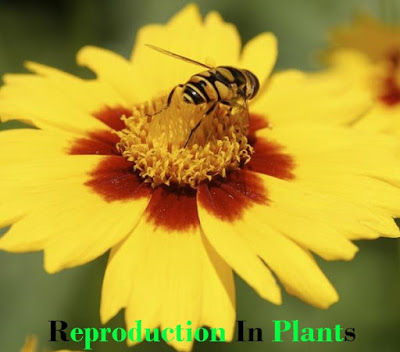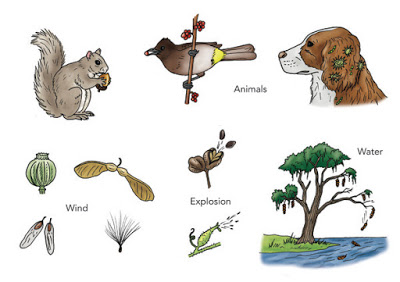
1) Fill in the blanks:
ANSWER :- (a) Production of new individuals from the vegetative part of
parent is called __vegetative propagation_ _.
parent is called __vegetative propagation_ _.
(b) A flower may have either male or female reproductive parts.
Such a flower is called __unisexual_ _.
Such a flower is called __unisexual_ _.
(c) The transfer of pollen grains from the anther to the stigma of
the same or of another flower of the same kind is known as
the same or of another flower of the same kind is known as
__pollination_ _.
(d) The fusion of male and female gametes is termed as
__fertilisation_ _.
__fertilisation_ _.
(e) Seed dispersal takes place by means of __wind_ _, __water_ _
and __animals __.
and __animals __.
2) Describe the different methods of asexual reproduction. Give
examples.
examples.
ANSWER:- Different methods of asexual reproduction are:
1. Fragmentation: Parent body divides into distinct pieces which
grow into new individuals. e.g. Spirogyra.
grow into new individuals. e.g. Spirogyra.
2. Budding: A small part of parent body grows out as a bud which
detaches and becomes a new individual. Sometimes a chain of buds is also
formed. e.g. yeast, corals, sponges etc.
detaches and becomes a new individual. Sometimes a chain of buds is also
formed. e.g. yeast, corals, sponges etc.
3. Spores Formation: Parent plant releases thousands of tiny,
spherical and unicellular spores which are protected by cell wall. When these
spores find favourable environment, they grow into plants. e.g. mosses, ferns,
moulds etc.
spherical and unicellular spores which are protected by cell wall. When these
spores find favourable environment, they grow into plants. e.g. mosses, ferns,
moulds etc.
4. Regeneration: Many plants like cacti, potato, rose, sugarcane
etc. reproduce by this method. New plants are produced from
vegetative parts of the mother plant such as root,
stem or leaves.
etc. reproduce by this method. New plants are produced from
vegetative parts of the mother plant such as root,
stem or leaves.
3) Explain what you understand by sexual reproduction.
ANSWER: – Sexual reproduction is a process which involves production of
seeds. It requires two parents.
Most plants reproduce sexually with the help of flowers. The main function of
a flower is to reproduce and therefore develop new
seeds that can grow into new plants.
seeds. It requires two parents.
Most plants reproduce sexually with the help of flowers. The main function of
a flower is to reproduce and therefore develop new
seeds that can grow into new plants.
4) State the main difference between asexual and sexual
reproduction.
reproduction.
ANSWER:-
ASEXUAL REPRODUCTION:-
i. Only one parent is needed.
ii.Offspring is genetically identical to its parent .
iii.Spirogyra, Yeast, moulds, potato exhibit asexual reproduction.
SEXUAL REPRODUCTION
i) Two parents or male and female gametes are required.
ii) Offspring exhibit variation with respect to its parents.
iii) Fruit bearing plants like mango, china rose reproduce sexually.
5) Sketch the reproductive parts of a flower.

6)Explain the difference between self-pollination and
cross-pollination.
cross-pollination.
ANSWER:-
Self-pollination:-
i) It involves the transfer of pollen
from the stamen to the pistil of the same flower.
from the stamen to the pistil of the same flower.
ii) It occurs only in bisexual flowers.
Cross-pollination:-
i) It involves the transfer of pollen from the stamen of one
flower to the pistil of another flower of the same plant or that of a different
plant of the same kind.
flower to the pistil of another flower of the same plant or that of a different
plant of the same kind.
ii) It occurs in both unisexual and bisexual flowers.
7) How does the process of fertilisation take place in flowers?
ANSWER: – After pollination, pollen grains start growing into a pollen tube
passing through pistil.
passing through pistil.
The tube reaches the ovule and enters it. The pollen tube carries
the male gametes. The male gametes
fuse with the ova (female gamete) and form a zygote. This process of fusion is
called fertilization. Later zygote develops into an embryo. Meanwhile walls of
the ovules develop into layers and form a seed. Thus a seed carries an embryo with stored food and is covered by a hard
coating.
the male gametes. The male gametes
fuse with the ova (female gamete) and form a zygote. This process of fusion is
called fertilization. Later zygote develops into an embryo. Meanwhile walls of
the ovules develop into layers and form a seed. Thus a seed carries an embryo with stored food and is covered by a hard
coating.
8) Describe the various ways by which seeds are dispersed.
ANSWER: –

(a) Dispersal by animals − There are many ways by which birds and
animals can disperse seeds. For
example, birds and animals can eat the fruits and excrete the seeds away from
the parent plant. Some seeds have barbs or other
structures that get attached to the animal’s
body and are carried to new sites. Some fruits have hooks on them which cling
to fur or clothes.
animals can disperse seeds. For
example, birds and animals can eat the fruits and excrete the seeds away from
the parent plant. Some seeds have barbs or other
structures that get attached to the animal’s
body and are carried to new sites. Some fruits have hooks on them which cling
to fur or clothes.
(b) Dispersal by wind − Seeds that get dispersed by wind are
usually smaller in size or they have wings or hair-like structures. For
example, winged seeds of drumsticks, hairy fruit of
sunflower, etc. are dispersed by wind.
usually smaller in size or they have wings or hair-like structures. For
example, winged seeds of drumsticks, hairy fruit of
sunflower, etc. are dispersed by wind.
(c) Dispersal by water − Many aquatic plants or plants that live
near water has seeds that can float and
are carried away by water. For example, coconuts can float and are disperse by
water.
near water has seeds that can float and
are carried away by water. For example, coconuts can float and are disperse by
water.
(d) Dispersal by explosion − Sometimes the seeds are dispersed by
the bursting of fruits with sudden
jerks. The seeds get scattered of distributed far from the parent plant. Examples
of such plants are castor and balsam.
the bursting of fruits with sudden
jerks. The seeds get scattered of distributed far from the parent plant. Examples
of such plants are castor and balsam.
9)Match items in Column I with those in Column II
ANSWER:-
Column I Column II
(a) Bud. (iii) Yeast
(b) Eyes. (v) Potato
(c) Fragmentation (ii)
Spirogyra
Spirogyra
(d) Wings (i) Maple
(e) Spores. (iv) Bread mould
10) Tick (√ ) the correct answer:
(a) The reproductive part of a plant is the
(i) leaf
(ii) stem
(iii) root
(iv) flower
(b) The process of fusion of the male and female gametes is
called
called
(i) fertilisation
(ii) pollination
(iii) reproduction
(iv) seed formation
(c) Mature ovary forms the
(i) seed
(ii) stamen
(iii) pistil
(iv) fruit
(d) A spore producing plant is
(i) rose
(ii) bread mould
(iii) potato
(iv) ginger
(e) Bryophyllum can reproduce by its
(i) stem
(ii) leaves
(iii) roots
(iv) flower
ANSWER:-
a)(iv) flower
b)(i) fertilisation
c) fruit
d)(ii) bread mould
e)(ii) leaves